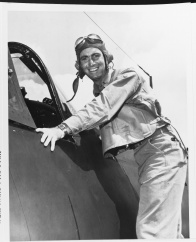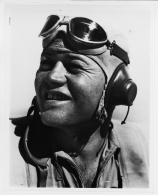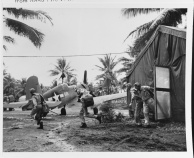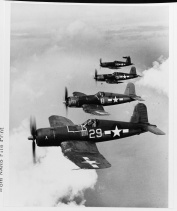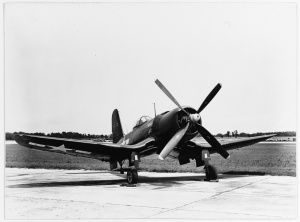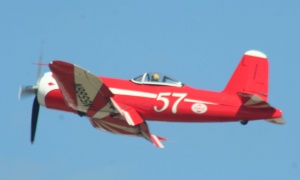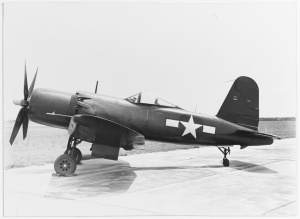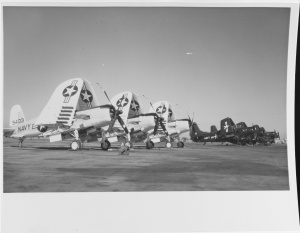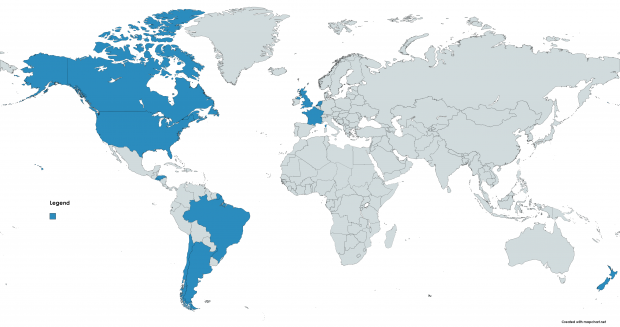F4U Corsair (Family)
Contents
Description
The F4U Corsair is an American fighter designed by Chance Vought and put into service in 1942. It served throughout WW2 until 1979 as well as in several air forces worldwide.
Vehicles
Rank II
- ▄Corsair F Mk II - British variant of the F4U-1A
- F4U-1A
- F4U-1A (USMC)
- ▅F4U-1A - Japanese captured Corsair
Rank III
Rank IV
- F4U-4B
- F4U-4B VMF-214
- F4U-7 - French variant of the Corsair
- AU-1
- F2G-1
History
Origin
In 1938 the Navy wanted to find a design for a carrier-based fighter with more performance than the Brewster F2A and Grumman F4F. The design contract was given to Vought, based on their proposal, which featured a plane dependent on the Pratt and Whitney R-2800 engine. The design included an inverted gull wing shape. This was necessary because the engine required a large propeller, which needed a large ground clearance. This would require very long landing gear, except the inverted gull wing shape allowed shorter landing gear, while maintaining the necessary ground clearance. The prototype, named XF4U-1 was armed with 4 machine guns, two .50 cal machine guns in the wings and two .30 cal machine guns on the engine cowling. The XF4U-1 first flew on May 29, 1940, and became the first single engine plane to fly over 400 mph. Before Vought was allowed to produce the plane though, they had to increase its armament, as it was deemed insufficient based on data from Europe. Its armament was changed to six .50 machine guns, and it was ordered into production. A self-sealing fuel tank in the fuselage above the wings caused the cockpit to be moved aft as well. The Navy ordered 584 F4U-1's on April 2, 1941.
Design
Powerplant
The F4U was powered by a Pratt and Whitney R-2800 engine. This was the most powerful and largest engine available when the F4U was being developed. An engine that powerful required a large propeller, 13 feet and 4 inches in diameter. The propeller was 3 bladed for all versions up until the F4U-4 when it got a 4 bladed propeller.
Wings and Landing Gear
Since the F4U was designed as a carrier-based fighter, the wings needed to be foldable, so the plane would take up less room on an aircraft carrier. In order to allow for the aircraft's wings to fold, the landing gear could not fold into the wings like many aircraft of the day, but would instead need to fold rearward. Unfortunately, due to the humongous 13-foot Hamilton Standard four-bladed propeller, the rearward folding landing gear would need itself to be extremely long in order to maintain propeller arc clearance, threatening the structural stability of the landing gear. To solve all of these problems, the aircraft's wing design was given inverted gull wings, which allowed the length of the landing gear to be reduced.
The F4U was very aerodynamic for its time. It utilized spot welding instead of rivets to decrease drag. It was also the first U.S. Navy aircraft to have landing gear that retracted into a fully enclosed wheel well, and the supercharger air intakes were located in the wings, instead of using scoops that protrude from the aircraft. The Corsair also used fabric to cover the parts of the wing aft of the main spar, the ailerons, rudder, and elevators. All of these factors significantly reduced drag, increasing the aerodynamics of the aircraft. Despite this, when using the flaps, the Corsair could still perform carrier landings, as the flaps could be angled at 60° to decrease speed while still maintaining enough lift to properly land.
Technical Issues
The F4U was not without its problems. Many of the issues it faced were related to its ability to be used on aircraft carriers such as having an aft placed cockpit and long "nose" at the front of the aircraft. This configuration reduced the pilot's visibility, which was important during carrier landings. In fact, the pilot could not see the Landing Signal Officer (LSO) for much of the landing approach. In addition, the hydraulically powered cowl flaps could potentially splatter hydraulic fluid onto the windscreen, limiting visibility even further. To prevent fluid splattering the solution was to affix the cowl flaps down permanently. The low visibility upon landing was later solved by the Fleet Air Arm of the Royal Navy.
In addition to the visibility issues, there were other issues involved with landing on a carrier. During a carrier landing, the right-wing would unexpectedly stall and send the aircraft into a spin. When the throttle was quickly turned up the left-wing would drop very quickly, also causing a spin or causing the pilot to lose control. This issue was fixed by adding a stall strip to the right-wing just outboard of the main armament. This strip was added to the leading edge of the wing and allowed the right-wing to stall at the same point as the left-wing. The hydraulic landing gear would also tend to bounce upon landing. This was solved by adding a "bleeder valve" that released hydraulic pressure gradually, allowing the landing gear to absorb some of the contact with the runway and to prevent bouncing upon landing.
Performance Against Contemporary Designs
The F4U Corsair performed very well against its contemporary rivals. Compared to the Grumman F6F Hellcat, the F4U was significantly faster. Compared to the Republic P-47 Thunderbolt, the F4U was 13 mph slower, but reached its maximum speed at a lower altitude, giving the F4U an advantage at lower altitudes. All three of these planes used the Pratt and Whitney R-2800 engine.
Service
United States
World War 2
On July 31 1942, the Navy received its first F4U-1. The framed canopy, the long nose, and the angle of the nose made it very hard to taxi on a carrier deck, as forward visibility was low. Despite all of the problems with the design, it was found that the Corsair could land on a carrier during carrier qualification on USS Wolverine, USS Core, and USS Charger. Navy squadron VF-12 soon completed deck landing qualification, in April of 1943. By this point the F6F Hellcat had entered service, and it was preferred over the F4U because it was much easier to land on a carrier. In 1942, the Corsair was sent to the Marine Corps to be used as a land-based fighter, since it still had issues landing on carriers.
In 1943, the Corsair started to be used by the Marine Corps, operating out of the Solomon Islands, notably, Guadalcanal. The first combat action was on 14 February 1943, when Corsairs of VMF-124 were escorting B-24 Liberator bombers, along with P-40 Warhawks and P-38 Lightnings. The Japanese launched an attack, and four P-38s, two P-40s, two F4Us, and two B-24s were lost. The Japanese lost four A6M Zeros, one of which was knocked out by an F4U, although it was because of an aerial collision, not combat.
On 26 March 1944, Corsairs recorded their first real kills. They shot down eight A6M Zeros while escorting B-25 bombers over Ponape. VMF-113 covered the landings at Ujelang, but quickly began striking targets in the Marshall Islands for the rest of 1944, since the landings were unopposed. One notable kill by a Corsair was when Marine Lieutenant R. R. Klingman of VMF-312 knocked out a Japanese aircraft by ramming its tail with his propeller, since his guns had jammed. He still managed to land safely, even though his propeller was missing five inches on the blades. At the Battle of Okinawa, a number of Corsair squadrons saw success, such as VMF-312, VMF-323, and VMF-224.
965 F4U-1As were built as land-based fighters, since they had not yet been cleared for carrier operations. These models had the hydraulic mechanisms for folding the wings removed. In addition, many had their arrestor wire hooks removed in the field. The modifications simplified the design and reduced unnecessary weight.
The Corsair had the ability to be used as a fighter-bomber, which was utilized by the Marine Corps, starting in 1944. Charles Lindbergh, working with the Marines as a civilian adviser, flew Corsairs in attempts to increase their payload. In the process, he flew missions against Japanese positions in the Marshall Islands, and got a Corsair in the air with 4,000 lbs of bombs. By 1945, the Corsair was performing missions with bombs, rockets, napalm, Tiny Tim rockets, and even Bat glide bombs. It fought over Iwo Jima, Peleliu, and Okinawa.
In the Solomon Islands, VF-17 reinstalled the tail hooks on their Corsairs, so they could land on the carriers they would be providing air cover for during the raid on Rabaul. The Navy finally cleared the Corsair for carrier operations in April of 1944 when the oleo struts were improved to eliminate bouncing on landing. VMF-124 became the first Corsair squadron to be based on an aircraft carrier in December 1944, along with VMF-213. The amount of Corsair squadrons operating from carriers increased over the course of the war, as they were necessary to help protect against kamikaze attacks.
WW2 Statistics:
- Total Operational Sorties: 64,051
- Percentage of Total USMC and USN Sorties: 44%
- Sorties from Carrier Decks: 9,581 (15%)
- Air Victories (Kills): 2,140
- Total Air Combat Losses: 189
- Total Ratio of Victories to Losses: 11:1
- Ratio of Kills to Losses Against A6M Zeros: 12:1
- Ratio of Kills to Losses Against Ki-84s, N1K-Js and J2Ms: 6:1
- Amount of Bombs Dropped: 15,621 Short Tons (14,171 metric tons)
- Percentage of Bombs Dropped by US Fighters: 70%
WW2 Losses:
- By Aerial Combat: 189
- By Anti-Aircraft Fire: 349
- During Combat Missions: 230
- During Non-Combat Missions: 692
- While on the Ground or Aboard Ships: 164
Korean War
By the time of the Korean War, there were more modern fighters than the F4U Corsair, including jet fighters. Because of this, the F4U was used, for the most part, in a close air support role, instead of that of a fighter. The Corsair versions used in Korea included F4U-4B, F4U-4P, F4U-5N, F4U-5NL, and AU-1. Early in the war, Corsairs saw some action dogfighting with Yak-9s. Later in the war, jet powered MiG-15s were seen. Generally, a piston-engined F4U would make an easy target for a jet powered MiG-15, but in one case an F4U was able to shoot down a MiG-15. Captain Jesse Folmar from the Marine Corps was able to catch a MiG-15 while it was low and slow, and was able shoot it down. He was shot down soon after, but was rescued quickly, and was back in the cockpit the next day.
Early in World War 2, the Royal Navy only had access to large, two seat planes with bad manoeuvrability. They quickly moved to replace them with newer designs, including naval variants of the Hawker Hurricane and the Supermarine Spitfire. These designs did not have the range necessary to operate from an aircraft carrier. The F4U Corsair was seen as an alternative. The Royal Navy received 95 F4U-1 Corsairs in November of 1943, and dubbed them Corsair Mk I. The squadrons were trained on the East Coast of the United States and then sent to Britain. The Royal Navy quickly learned of the Corsairs many flaws. There were multiple fatal crashes, as the Corsair was not yet optimized for carrier operations.
In order to clear the smaller bulkhead of their carriers, many Royal Navy Corsairs had their wings clipped by eight inches. The Royal Navy used a different landing approach than the US Navy. They would approach the carrier in a left-hand turn, in order to keep the deck in sight of the pilot. This approach was later adopted by the US Navy and Marine Corps, solving some of the problems of carrier landings. In addition, the Royal Navy was the first to add a number of modifications that further improved carrier landings. They raised the pilots seat by seven inches, gave the Corsair a new canopy with increased visibility, and permanently shut the cowl flaps on the engine.
After the modifications were installed on the Corsair Mk I, the Royal Navy received 510 -1A and -1D Corsairs, designated Corsair Mk II in Fleet Air Arm service. They also received 430 Brewster-built F3A-1 and F3A-1D Corsairs, known as Corsair Mk III. In addition, 857 Goodyear Corsairs, of FG-1, FG-1A, and FG-1D types, were received and designated Corsair Mk IV. Only the Corsair Mk IIs and Corsair Mk IVs were used in combat by the Royal Navy.
Royal Navy Corsair squadrons were trained and equipped in the United States, and then shipped to combat zones. The Royal Navy cleared the Corsair for carrier operations much before the United States did. In the European Theater, the Corsair was used in Operation Tungsten in 1944. This was an attempt to sink the German battleship Tirpitz. Corsairs from the HMS Victorious and HMS Formidable provided air cover during the attacks. In the Pacific Theater, the Corsair was used in multiple major attacks, including Operation Cockpit in 1944. In July and August 1945, the Corsair was used in attacks on the Japanese mainland. Throughout the War, 18 Royal Navy squadrons were equipped with Corsairs. Eight of those squadrons saw combat, and achieved 47.5 aerial kills.
New Zealand
In the Pacific, the Royal New Zealand Air Force (RNZAF) was equipped with Curtiss P-40 Warhawks. Although these aircraft had shown their age and weaknesses when compared to the Japanese aircraft they faced, the RNZAF squadrons performed admirably in aerial combat. Because of this, the United States decided to allow New Zealand to use F4U Corsairs since they were not yet being used on carriers. They were first delivered to New Zealand in 1944, replacing P-40 Warhawk and SBD Dauntless. Corsairs equipped all ten RNZAF fighter squadrons in the Pacific Because it arrived so late in the war, there were not very many Japanese planes for the RNZAF Corsairs to engage, at least in the zones they operated in. Mostly they supported the ground forces from New Zealand, Australia, and the United States. After the war, in 1945, all but one (No. 14) RNZAF squadrons disbanded. Squadron No. 14 was based in Japan until 1947 when the Corsair was retired from service.
Most of the combat Corsairs saw during the war was dropping bombs, rockets, napalm, and using their cannons to attack ground targets. In addition, the night fighter versions (F4U-5N/NL) were used to intercept attacks by enemy fighters such as the Po-2 biplane. The Po-2 made attacks at night, harassing UN forces. It was hard to shoot down because they flew very low and slow, and the wooden biplane was hard to find on radar. F4U's were also used to attack enemy convoys and supply lines, with the help of C-47 Dakotas/Skytrains. The C-47 would mark the targets with flares, so the F4Us could accurately attack them. F4Us were credited with 12 enemy planes shot down during the war. Navy pilot Guy Bordelon became the only Navy ace in the war, and also the only night ace, and the only American to become an ace in a piston-engine aircraft during the war.
Captured Corsairs
In July of 1944, a Royal Navy F4U-1A was involved with an anti-submarine patrol. Due to technical issues, the Corsair had to land in Norway. The pilot was captured, and the Corsair was sent to a testing facility at Erprobungsstelle Rechlin in Germany. At some point in the war, the Japanese had captured two Corsairs and likely tested one of them. It was discovered after the war ended near the Kasumigauru flight school.
France
After World War 2, France was gifted with four aircraft carriers, two from the US Navy, and two from the Royal Navy. They were equipped with Douglas SBD Dauntlesses, Curtiss SB2C Helldivers, and Grumman F6F-5 Hellcats. These aircraft were starting to show their age, and lack of performance compared to contemporary designs. They needed replaced, and the plane that would replace them was the F4U Corsair.
First Indochina War
The F4U-7 was specifically designed for the Aéronavale, and was the last production variant of the F4U Corsair. The last corsair rolled out of the factory on 31 January 1953, the last of 94 F4U-7s. They were bought by the US, and then given to the Aéronavale through the US Military Assistance Program (MAP). They fought in the First Indo China War for three months, flying 959 combat missions. They dropped 700 tons of bombs, fired 70,000 x 20 mm cannon rounds, and more than 300 rockets. Two Corsairs were shot down by the Viet Minh, and six more were damaged. Along with the 94 F4U-7s, there were 25 AU-1s lent by the US, which were returned after the war.
Suez Crisis (Operation Musketeer)
Operation Musketeer, the code name for the Anglo-French-Israeli seizure of the Suez Canal in 1956. The goal of the Corsair flotillas (14F and 15F) was to destroy ships of the Egyptian Navy at Alexandria. This did not come to fruition, as there were US Navy ships present, deterring the attack. Instead, the Corsairs attacked airfields in the Nile Delta. In this action, one Corsair was shot down, and two more were damaged upon landing on the aircraft carriers. Throughout the operation, Corsairs dropped 25 tons of bombs, fired over 500 rockets, and 16,000 x 20 mm cannon shells.
Algerian War
After Operation Musketeer, the three Corsair flotillas were moved to Telergma and Oran airfields in Algeria in 1956. From there they escorted helicopters and provided close air support. During the Algerian War, French Corsairs flew CAS missions between 1955 and 1962. In 1958, between February and March, F4U Corsairs flew missions from Bois Belleau (formerly the USS Belleau Wood), the only aircraft carrier involved in the war.
Tunisia
In 1956, the French recognized Tunisian independence, but did not remove their troops from the airbase in Bizert. Tunisia asked France to remove their troops in 1961, but France did not comply. On 17 July, Tunisia blockaded the base in an attempt to force France to withdraw from the base. A battle ensued that lasted three days. Corsairs from the 12F and 17F flotillas escorted paratrooper reinforcements to the base. In addition, the Aéronavale launched attacks on the Tunisian soldiers and vehicles. Three Corsairs were damaged by ground fire, and they launched over 150 sorties throughout the conflict.
ATGM Experiments
In 1959 the Aéronavale experimented with equipping Corsairs with SS.11 wire guided ATGMs. In order to use them in battle, the pilot had to guide the missile by joystick with his right hand at about 2 km from the target, while keeping track of it, while steering the plane with his left hand. Supposedly, the experiments proved successful, although no Corsairs were ever equipped with the ATGMs, even during the Algerian War that was going on at the time. All of the French Corsairs had been removed from service by 1964.
"Football War"
The last combat the F4U Corsair saw in its long career was during the 1969 "Football War". This war was fought between Honduras and El Salvador and was presumably initiated after a soccer game between the two countries. The air forces of the two countries were equipped with only propeller-driven aircraft, and the war was the last conflict involving combat between propeller-driven aircraft. On 17 July 1969, Captain Fernando Soto of the Honduran Air Force shot down a Cavalier Mustang and two FG-1 Corsairs of the Salvadoran Air Force. No Honduran aircraft were shot down during the course of the war, even though private American pilots with experience flying P-51s and F4Us were hired to fly combat missions by El Salvador. Both sides used Corsairs during the conflict.
Notable Pilots and Squadrons
- Ira C. Kepford - A member of the famed VF-17 "Jolly Rogers" squadron, Kepford achieved a total of 16 confirmed kills in his F4U-1A.
- Roger R. Hedrick - A member of VF-17, and later the Commanding Officer of VF-84, he got 12 confirmed kills in an F4U-1A and F4U-1D.
- John T. Blackburn - He was the first Commanding Officer of VF-17, credited with 11 kills in his F4U-1A.
- Thomas H. Reidy - A member of VBF-83, he was credited with 10 kills.
US Marine Corps Aces
- Gregory "Pappy" Boyington - The Marine Corp's top scoring ace, achieving 22 confirmed kills in an F4U-1A as part of VMF-214.
- Kenneth A. Walsh - He had 21 confirmed kills in an F4U-1 and F4U-4, as part of VMF-124. He later was the Operations Officer of VMF-222.
- James E. Swett - Serving in VMF-221 he was credited with 8.5 kills in an F4U, sharing one A6M "Zero" kill with another pilot. Before he flew the F4U he became an ace in a day by shooting down 7 planes in one action.
- Archie Donahue - He is credited with 12 kills in an F4U while serving in VMF-112.
US Marine Corps Squadrons
- VMF-124 - The squadron was declared fully operational on 28 December 1942, even though its pilots only had an average of 25 hours in the Corsair. The first Marine Corsair ace was Kenneth A. Walsh, who had achieved 20 out of his 21 aerial victories as part of VMF-124. The Squadron first fought in the Solomon Islands, and later became the first Marine squadron to be based on an aircraft carrier, along with VMF-213. VMF-124 and VMF-213 became the first Marine squadrons to launch a ground attack off of an aircraft carrier on 3 January 1945, when they struck Formosa and the Ryukyu Islands.
- VMF-214 "Blacksheep" - In 1943 the squadron was reinstated under the command of Major Gregory "Pappy" Boyington. They called themselves the Black Sheep. During their combat under Boyington's command, the squadron destroyed or damaged 203 enemy planes, with an official tally of 97 aerial victories. They also destroyed multiple enemy auxiliary ships and enemy installations. The squadron produced nine aces during the war.
- VF-17 "Jolly Rogers" - VF-17 was the second US Navy squadron to receive F4U-1 Corsair fighters, in 1943. The Corsair had not been cleared for carrier operations by the time the squadron was equipped with it, and as a result the squadron operated off of the ground in the Solomon Islands. They amassed 152 aerial victories, and produced 11 aces. The commander of the squadron was Lieutenant Commander John T. Blackburn. Other notable members of the squadron include Ira C. Kepford and Roger R. Hedrick.
Variants
In-Depth Variant History
Goodyear F2G "Super Corsair"
| The F2G Corsair is often referred to as "Super Corsair", though that was never an official designation. |
Genesis
Pratt & Whitney fitted an F4U-1 Corsair (Bu.No. 02460) - donated to them by the Navy - with their R-4360-4 Wasp Major engine in March 1943. The P&W R-4360-4 Wasp Major engine put out approximately 50% more power than the original P&W R-2800-1 Double Wasp used in other Corsairs; the 28-cylinder R-4360-4 was able to produce 3,000 horsepower. The F4U-1 fitted with the R-4360-4 was designated as F4U-1WM, and it was proven as a success after testing. As such, development of a production Corsair fitted with the R-4360 was given to Goodyear on 22 March 1944, when the Navy ordered 418 F2G-1 Corsairs and 10 F2G-2 Corsairs (a navalized variant with carrier capability).
Development
Seven prototypes were built and designated as XF2G-1, being modified production FG-1 Corsairs (a Goodyear-produced, fixed wing "de-navalized" version of the Corsair). The first XF2G-1 (Bu.No. 13471) was fitted with the R-4360 engine but retained many characteristics of the standard Corsair, including the canopy and cockpit, though the engine cowling was extended and an air scoop was added on top of the fuselage right behind the engine cowling. It began ground testing on 31 May 1944, and first flew on 26 August of the same year. The second XF2G-1 (Bu.No. 13472) was used to test new aspects including oil coolers and propellers, which would be used on later XF2G-1s.
The remaining five prototypes (Bu.Nos. 14691 through 14695) were modified much more extensively. They featured a new bubble canopy and a reduced spine, in order to provide better visibility to the pilot. Additionally, the cockpit was redesigned; it received a floor and new controls quite similar to those used on the Vought F4U-4 version of the Corsair. The XF2G-1 retained the six .50 cal (12.7 mm) machine guns of the FG-1 as well as the same ordnance carrying capability, but they were modified to allow the carrying of external, jettisonable fuel tanks for extended range.
Bu.No. 14691 used the engine taken from the first prototype, Bu.No. 13471, and it first flew on 15 October 1944. Bu.No. 14692 added wing-mounted fuel tanks and improved vertical control surfaces. Bu.No. 14693 was fitted with the R-4630-4W version of the R-4630 engine, which introduced water-ethanol injection for increased power, but the -4W version of the engine was not fitted to any other version of the F2G. The final XF2G-1, Bu.No. 14695, had its first flight on 4 December 1944, but was wrecked in the hangar soon after by a crane and was not repaired.
On 27 November 1944, the XF2G-1 was given to the U.S. Navy for testing. Some issues arose during testing, particularly that the engine torque of the engine would cause the aircraft to turn hard to the left in a carrier wave off (when increasing the throttle in the case that the landing had to be aborted). In the case of a wave off and the throttle being applied, the rudder was not able to prevent the nose swinging to the left. To prevent this effect, the rudder was heightened by twelve inches and an auxiliary rudder was installed beneath it which would automatically turn 12.5 degrees to the right when the landing gear was extended, in order to counteract the torque of the engine.
Production
The first production F2G-1 (Bu.No. 88454) was delivered to the Navy on 15 July 1945, but the contract for production had been cut down to only five F2G-1 and five F2G-2 two months earlier in May. Production therefore ended in August 1945 after only 5 F2G-1 (Bu.Nos. 88454 through 88458) and 5 F2G-2 (Bu.Nos. 88459 through 88463) had been produced, for a total of eighteen F2G aircraft built of all variants, including the F4U-1WM. The Navy continued testing of the F2G series after production cancellation but dropped the F2G completely soon after.
Production of the F2G had been cancelled due in part to disappointing test results. The F2G-1 had an impressive climb rate of 4,400 feet per minute, but its top speed of 430 mph (692 km/h) was rather disappointing, and it also had some stability issues. Overall, its performance wasn't a large enough improvement over other aircraft in production, particularly the F4U-4 and F8F-1 Bearcat, which is why the production orders for the F2G were cancelled.Post-War Use - Racing
The F2G was much more successful post-war, many of the aircraft having served well as air racing aircraft, the most famous of which being the fifth production F2G-1 (Bu.No. 88458) known as "Race 57", famous for its bright red color scheme. Bu.No. 88463, the last F2G-2 produced, was also a racing aircraft known as "Race 74" and painted dark blue. Race 74 was destroyed in a crash in 2012 that also killed the pilot, Bob Odegaard. Only two F2G aircraft survive as of January 2021, which are the Bu.No. 88458 "Race 57" and Bu.No. 88454, both F2G-1s.
List of F2G Aircraft
F4U-1WM
- Bu.No. 02460
XF2G-1
- Bu.No. 13471
- Bu.No. 13472
- Bu.No. 14691
- Bu.No. 14692
- Bu.No. 14693 - "Race 94"
- Bu.No. 14694 - "Race 18"
- Bu.No. 14695
F2G-1
- Bu.No. 88454 - N/A - Display, Museum of Flight, Seattle, Washington
- Bu.No. 88455
- Bu.No. 88456
- Bu.No. 88457 - "Race 84"
- Bu.No. 88458 - "Race 57" - Flightworthy, Louise M. Thaden Airfield, Bentonville, Arkansas (owned by Steuart Walton)
F2G-2
- Bu.No. 88459
- Bu.No. 88460
- Bu.No. 88461
- Bu.No. 88462
- Bu.No. 88463 - "Race 74"
Note: There was an aircraft named Super Corsair and later "Race #1" , which despite the name was not an F2G. It was an F4U-1D fitted with the R-4360 engine, clipped wings, and a modified cockpit.
Variants Summary
Chance Vought (F4U/AU)
- XF4U-1
- The prototype for the F4U-1. It had a Pratt and Whitney XR-2800-4 engine and four machine guns; one in each wing and two in the nose. One built.
- F4U-1 (Corsair Mk I)
- The first production F4U. It was substantially different from the prototype, with the “bird cage” cockpit moved back to make room for fuselage fuel tanks and three guns in each wing. It had a more powerful Pratt and Whitney R-2800-8 engine. Production figures included with the F4U-1A.
- F4U-1A (Corsair Mk II)
- Mid-to-late production Corsairs saw the canopy changed to a clear-view canopy with only 2 frames in order to increase field of vision, and also a new windscreen that was easier to see through. This allowed the rear-view windows to be removed from the design. The pilot’s seat was also raised, to allow better view over the long nose. This was the first design to incorporate the stall strip on the leading edge of the right wing and the improved landing gear oleo-struts. These changes allowed the Corsair to be used in carrier landings. F4U-1As later incorporated a new R-2800-8W water injected engine, which was more powerful. F4U-1As in FAA service were known as Corsair Mk II, and had 8 in clipped off their wings, in order to fit on the Royal Navy aircraft carriers. 2,814 F4U-1s and F4U-1As were built. Some claim that this designation is unofficial, but these claims are not widely accepted by aviation historians.
- F4U-1B
- Unofficial post-war designation given to F4U-1s modified for Fleet Air Arm usage.
- F4U-1D (Corsair Mk II)
- An F4U-1 with an R-2800-8W water injected engine, which gave 250 hp more power. It could carry double the rockets of the F4U-1A, and as such had to have bomb pylons and rocket tabs bolted onto the plane, causing drag. Despite this, it still had a considerable range, as the ability to mount an additional belly drop tank. It had the “blown” canopy, with only a single piece. 1,685 were built.
- F4U-1C
- These were F4U-1Ds but had four 20 mm AN/M2 cannons, instead of six .50 in machine guns. Machine guns were preferred for aerial combat, but the 20 mm cannons were proven in a ground attack role. 200 built
- F4U-1P
- An F4U-1 but with photo reconnaissance equipment.
- V-354 (F4U-1 trainer)
- A single F4U-1 modified with a second seat in front of the main cockpit as a prototype for a trainer version of the F4U. It was never given an official Navy designation, so it is only known by its company name.
- XF4U-2
- Prototype for a night fighter variant, with two auxiliary fuel tanks.
- F4U-2
- F4U-1s modified with the outboard right machine gun removed and replaced with an Airborne Intercept radar on the outboard starboard wing. It was intended to be a night fighter. 34 modified from "bird cage" F4U-1s.
- XF4U-3
- Experimental variant used to test different engines in the Corsair airframe. One built, but photo evidence suggests it may have been from parts from a "bird cage" F4U-1.
- XF4U-3B
- Another XF4U-3 airframe with slight modifications.
- XF4U-4 and F4U-4X
- Prototypes incorporating a new engine and cowling. XF4U-4 unbuilt, but two F4U-1As were modified as F4U-4Xs.
- F4U-4
- This variant incorporated the new, more powerful, R-2800-18W dual-stage-supercharged engine. The power could be boosted by injecting an alcohol/water concentration to the engine. An air scoop was added to the nose of the plane, and the fuel tanks in the wings were removed. This version had a 4-bladed propeller, instead of a 3-bladed propeller. The windscreen was also changed to flat, bulletproof glass, to reduce distortion. 2050 built.
- F4U-4C
- F4U-4s with four 20 mm AN/M2 cannons instead of six .50 in machine guns.
- F4U-4B
- Redesignated F4U-4Cs. Some sources claim F4U-4B was the designation for F4U-4s intended for the FAA, but there is little evidence to support these claims. 297 built.
- F4U-4E
- Night fighter variant of the F4U-4 with an APS-4 search radar on the starboard wing tip. Some had four 20 mm AN/M2 cannons instead of six .50 in machine guns. Few built.
- F4U-4N
- Night fighter variant of the F4U-4 with an APS-6 search radar on the starboard wing tip. Some had four 20 mm AN/M2 cannons instead of six .50 in machine guns. Few built.
- F4U-4K
- Drone variant modified from F4U-4s.
- F4U-4P
- Photo reconnaissance variant of the F4U-4. 9 built.
- XF4U-5
- Had a new engine cowling, among other modifications. 3 modified from F4U-4s.
- F4U-5
- A modification of the F4U-4. It incorporated a new R-2800-32(E) engine, a modernized cockpit, all-metal wings, a completely retractable tail wheel, and other modifications. Cannon armament was now standard. 223 built.
- F4U-5N
- F4U-5 with a radar. 214 built.
- F4U-5NL
- Variant of the -5N modified for operations in a winter environment. It had de-icing boots on the leading edges of the tail and wings. 72 new aircraft built, 29 more were modified from existing F4U-5Ns.
- F4U-5P
- A long range photo reconnaissance variant of the -5. 30 built.
- XF4U-6
- Prototype for the F4U-6/AU-1. 1 built.
- F4U-6/AU-1
- The F4U-6 was a variant designed for ground attack missions for the Marine Corps. It had extra armour for the fuel tank and pilot, and relocated the oil coolers. It also featured a simplified supercharger, in order to optimise it for low altitude flying. It could carry up to 8,200 lbs of bombs, much more than other variants. This caused its top speed to be much lower than other variants. It was later redesignated as the AU-1. 111 built.
- F4U-7
- AU-1 modified for use with the French Navy. 94 built.
Goodyear (FG/F2G)
- FG-1
- F4U-1 built by Goodyear for the Marine Corps. They had wings that could not be folded. Production figures included with the FG-1A.
- FG-1A
- F4U-1As built by Goodyear for the Marine Corps. They had wings that could not be folded. 2,009 FG-1s and FG-1As were built.
- FG-1D (Corsair Mk IV)
- F4U-1D built by Goodyear. It had the wingtips clipped for FAA service. 1,997 built.
- FG-1E
- An FG-1 with radar equipment. Produced by Goodyear.
- FG-1K
- A drone variant of the FG-1.
- FG-3
- Airframes made by Goodyear that were used for the XF4U-3 project.
- FG-4
- F4U-4 produced by Goodyear. Not built.
- XF2G-1
- Single FG-1 modified with a Pratt and Whitney R-4360, Wasp Major 4-row 28-cylinder radial engine and a bubble canopy. It had manual-folding wings and a 14 ft propeller.
- F2G-1
- Production version of the XF2G-1. Intended for the USMC, never entered service. 5 built.
- F2G-2
- F2G-1 with hydraulically folding wings, a tailhook for carrier landings, and a 13 ft propeller. Intended for the USN, never entered service. 5 built.
Brewster (F3A)
- F3A-1 (Corsair Mk III)
- F4U-1 license-built by Brewster. Poor quality caused the contract to be terminated by the Navy. Known as the Corsair Mk III in FAA service. None of these Corsairs saw frontline service because of their production defects. 334 built.
- F3A-1D (Corsair Mk III)
- F4U-1D license-built by Brewster. Poor quality caused the contract to be terminated by the Navy. This version, although different than the F3A-1, was still known as the Corsair Mk III in FAA service. It had the wingtips clipped for FAA service. 96 built.
Operators
- Argentina - Argentine Navy operated 26 F4U-5/5N/5NL Corsairs from 1956 to 1968.
- Canada - Royal Canadian Navy operated 130 F4U-1D from 1948 to 1960.
- El Salvador - Air Force of El Salvador operated 25 F4U/FG-1D from 1957 to 1976.
- France - French Navy operated 69 AU-1 and 94 F4U-7 from 1954 to 1964.
- Honduras - Honduran Air Force operated 19 from 1956 to 1979.
- Netherlands - Royal Netherlands Navy operated 35 F4U-1D from 1943 to 1956.
- New Zealand - Royal New Zealand Air Force operated 368 F4U-1 and 60 FG-1D from 1944 to 1949.
- United Kingdom - Royal Navy Fleet Air Arm operated 2,012 Corsairs of all types during World War 2, including 95 Corsair I (F4U-1), 510 Corsair II (F4U-1A), 430 Corsair III (F3A-1D), and 977 Corsair IV (FG-1D).
- United States - United States Navy and Marine Corps operated Corsairs of all production variants from 1942 to 1953.














